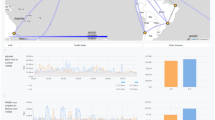Abstract
The 24-H Knowledge Factory facilitates collaboration between geographically and temporally distributed teams. The teams themselves form a strategic partnership whose joint efforts contribute to the completion of a project. Project-related tasks are likewise distributed, allowing tasks to be completed on a continuous basis, regardless of the constraints of any one team’s working hours. However, distributing a single task between multiple teams necessitates a handoff process, where one team’s development efforts and task planning are communicated from one team ending their shift to the next that will continue the effort. Data management is, therefore, critical to the success of this business model. Efficiency in data management is achieved through a strategic leveraging of key tools, models, and concepts.







Similar content being viewed by others
References
Ahituv, N., Igbaria, M., & Sella, A. (1998). “The effects of time pressure and completeness of information on decision making”. Journal of Management Information Systems, 15(2), 153–172.
Battin, R., Crocker, D., Kreidler, J. & Subramanian, K. (2001) “Leveraging Resources in Global Software Development”, IEEE Software, Vol. 18, Issue 2
Beck, K. (2000) “Extreme Programming Explained: Embrace Change”, Addison Wesley
Berger, S. (2006). How we compete: What companies around the world are doing to make it in today's global economy. New York and London: Currency Doubleday.
Birkinshaw, J., & Sheehan, T. (2002). Managing the knowledge life cycle. MIT Sloan Management Review, 44(1), 75–83.
Brooks Jr, F. P. (1995) “The Mythical Man-Month”, Addison-Wesley
Carmel, E. & Agarwal, R. (2002) “The Maturation of Offshore Sourcing of Information Technology Work”, MIS Quarterly Executive, Volume 1, Issue 2
Crk, I., Sorensen, D., & Mitra, A. (2008). “Leveraging Knowledge Reuse and System Agility in the Outsourcing Era”. Journal of Information Technology Research, 1(2), 1–20.
Dekleva, S. (1992). Delphi study of software maintenance problems. Conference on Software Maintenance Proceedings, 9(12), 10–17.
Denny, N., Crk, I., & Seshu, R. (2008a). “Agile Software Processes for the 24-Hour Knowledge Factory Environment”. Journal of Information Technology Research, 1(1), 57–71.
Denny, N., Mani, S., Seshu, R., Swaminathan, M., & Samdal, J. (2008b). “Hybrid Offshoring: Composite Personae and Evolving Collaboration Technologies”. Journal of Information Technology Review, 21(1), 89–104.
Freeman, E. & Gelernter, D. (1996) “Lifestreams: A Storage Model for Personal Data”, ACM SIGMOD Record
Gao, J. Z., Chen, C., Toyoshimo, Y., & Leung, D. K. (1999). “Engineering on the Internet for Global Software Production”. IEEE Computer, 32(5), 38–47.
Gupta, A. (2001) “A Four-Faceted Knowledge Based Approach to Surmounting National and Other Borders.” The Journal of Knowledge Management, Vol. 5, No. 4, 2001
Gupta, A. & Seshasai, S. (2007) “24-Hour Knowledge Factory: Using Internet Technology to Leverage Spatial and Temporal Separations”, ACM Transactions on Internet Technology, Vol. 7, No. 3, Article 14
Knuth, D. (1984). “Literate Programming”. The Computer Journal, 27(2), 97–111.
Myopolous, J. (1998). “Information Modeling in the Time of Revolution”. Information Systems, 23(3), 127–155.
Nonaka, I. (1994). “A dynamic theory of organizational knowledge creation”. Organization Science, 5(1), 14–39.
O’Toole, K., Subramanian, S., & Denny, N. (2008). “Voice-Based Approach for Surmounting Spatial and Temporal Separations”. Journal of Information Technology Research, 1(2), 54–60.
Quinn, J. B. (1999). “Strategic Outsourcing: Leveraging Knowledge Capabilities”. Sloan Management Review, 40(4), 9–21.
Quintas, J. B., Anderson, P., & Finkelstein, S. (1996). ``Managing professional intellect: making the most of the best''. Harvard Business Review, 74, 71–80.
Sambamurthy, V., Bharadwhaj, A., & Grover, V. (2003). “Shaping Agility through Digital Options: Reconceptualizing the Role of Information Technology in Contemporary Firms,”. MIS Quarterly, 27(2), 237–263.
Scarbrough, H. (1998). “BPR and the knowledge-based view of the firm”. Knowledge and Process Management, 5(3), 192–200.
Searle, J. R. (1969). Speech Acts. London: Cambridge University Press.
Searle, J.R. (1975) “A Taxonomy of Illocutionary Acts. Language, Mind and Knowledge”, Minnesota Studies in the Philosophy of Science, pgs 344-369
Seshasai, S. & Gupta, A. (2007) "Harbinger of the 24-Hour Knowledge Factory" Available at SSRN: http://ssrn.com/abstract=1020423
Schwaber, K., & Beedle, M. (2002). Agile Software Development with Scrum. Series in Agile Software Development, Upper Saddle River, NJ: Prentice Hall.
Spender, J. C. (1996). “Organizational knowledge learning and memory: three concepts in search of a theory”. Journal of Organizational Change Management, 9(1), 63–78.
Suchan, J. & Hayzak, G. (2001) “The communication characteristics of virtual teams: a case study”, IEEE Transactions on Professional Communication, Vol. 44, No. 3
Todd, P., & Benbasat, I. (1991). “An experimental investigation of the impact of computer-based decision aids on decision making strategies”. Information Systems Research, 2(2), 87–115.
Vessey, I., & Sravanapudi, A. P. (1995). “Case Tools as Collaborative Support Technologies”. Communications of the ACM, 38(1), 83–95.
Yang, H. L. (1995). “Information/knowledge acquisition methods for decision support systems and expert systems”. Information Processing and Management, 31(1), 47–58.
Whitehead, E. J. (1997) “World Wide Web Distributed Authoring and Versioning (WebDAV): An Introduction”, StandardView 5, pgs 1, 3–8
Acknowledgements
We would like to acknowledge the following current and former members of the 24-Hour Knowledge Factory Research Group at the University of Arizona for their research ideas: Nathan Denny, Kate O’Toole, Shivaram Mani, Ravi Seshu, Manish Swaminathan, and Jamie Samdal
Author information
Authors and Affiliations
Corresponding author
Rights and permissions
About this article
Cite this article
Gupta, A., Crk, I. & Bondade, R. Leveraging temporal and spatial separations with the 24-hour knowledge factory paradigm. Inf Syst Front 13, 397–405 (2011). https://doi.org/10.1007/s10796-009-9226-4
Published:
Issue Date:
DOI: https://doi.org/10.1007/s10796-009-9226-4




